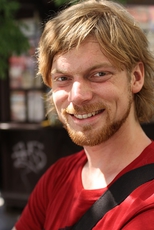
Dipl.-Inf. Markus Mayer
Alumnus of the Pattern Recognition Lab of the Friedrich-Alexander-Universität Erlangen-Nürnberg
The vision of my work is to develop image processing methods that provide new tools for ophthalmologists to ease the detection of glaucoma and related eye diseases.
Introduction to my research
My research concentrates on Optical Coherence Tomography (OCT) image processing. The development of an automated glaucoma detection system is the center that other projects contribute to. The steps involved in developing an automated detection system are split into data preprocessing, segmentation of relevant structure, feature computation and finally a classification. Each of my following projects contribute to at least one part of the classification chain.
The project  "Advanced fundus imaging for early detection of eye diseases" provides the framework where the other projects fit in. It is funded by the Erlangen Graduate School in Advanced Optical Technologies (SAOT) by the German Research Foundation (DFG) in the framework of the German excellence initiative. "Advanced fundus imaging for early detection of eye diseases" provides the framework where the other projects fit in. It is funded by the Erlangen Graduate School in Advanced Optical Technologies (SAOT) by the German Research Foundation (DFG) in the framework of the German excellence initiative.
|
 |
 |
Within the  "Automated Retinal Layer Segmentation" project we develop segmentation tools for circular and volume scan OCT data. A special focus lies on robust segmentations that are applicable on images of normal subjects as well as of patients.
For this project, the "Automated Retinal Layer Segmentation" project we develop segmentation tools for circular and volume scan OCT data. A special focus lies on robust segmentations that are applicable on images of normal subjects as well as of patients.
For this project, the  OCTSEG Software for segmenting and visualizing OCT data was written. This software is downloadable and may be used for free. OCTSEG Software for segmenting and visualizing OCT data was written. This software is downloadable and may be used for free.
|
The  "OCT Image Denoising" project wants to enhance the useability of OCT data. On one hand denoising of images is a step in a segmentation chain. It prevents the computer from being confused by detecting false edges created by noise. On the other hand denoising may enhance the visual impression of OCT images for humans. "OCT Image Denoising" project wants to enhance the useability of OCT data. On one hand denoising of images is a step in a segmentation chain. It prevents the computer from being confused by detecting false edges created by noise. On the other hand denoising may enhance the visual impression of OCT images for humans.
|
 |

|
 "Automated Glaucoma Classification" "Automated Glaucoma Classification" calculates a number that represents the possibility of a subject suffering from glaucoma. The features used in the classification step can be generated from geometric meassurements (e.g. segmentation) or data-driven methods. "Automated Glaucoma Classification" "Automated Glaucoma Classification" calculates a number that represents the possibility of a subject suffering from glaucoma. The features used in the classification step can be generated from geometric meassurements (e.g. segmentation) or data-driven methods.
|
My main interests
- Automatic detection of eye diseases
- Image processing of Optical Coherence Tomography (OCT) data
- Preprocessing (denoising, motion correction, intensity normalization)
- Segmentation of retinal layers
- Visualisation
Research Vision
I am a supporter of open and reproducible research. Therefore you will find code and programs I developed on my  Programs & Code webpage. If you have any questions, do not hesitate to write me a
Programs & Code webpage. If you have any questions, do not hesitate to write me a ![]() mail!
mail!




